The Vietnamese as “the Hereditary Enemy”
Today, the Court heard the testimony of witness 2-TCW-1000, who was interviewed anonymously: he had been interviewed in Case 003 and confidentiality needed to be respected. The former soldier had worked under Meas Muth in a navy battalion during the Khmer Rouge period and submitted evidence regarding the killing of many Vietnamese refugees and Thai fishermen. Moreover, he claimed that they had been instructed in training sessions to kill all Vietnamese – including children – since these were regarded as the hereditary enemy of the Khmer people. Previously he had been working as a soldier under the Lon Nol regime and therefore regarded it as his main task to re-fashion himself.
Submission regarding Prak Doeun’s testimony
At the beginning of the morning session, the Trial Chamber Greffier reported the attendance of all parties with Nuon Chea participating from the holding cell. The floor was then granted to the Defense Team for Nuon Chea for making comments on a document.
Mr. Victor Koppe made submissions about the testimony of Prak Doeun of December 03 2015. Mr. Koppe had wanted to ask whether he was ever accused of having killed his own wife. “You might remember that when I was asked by Judge Fenz why I was asking this question, that this question was triggered by something” that the Civil Party himself had said in his Civil Party application. Mr. Koppe recounted that he wanted to ask the person whether criminal proceedings had occurred. Mr. Koppe said that later, they found a written civil party application by the same lawyer as the one from Prak Doeun.[1] “I know of one Khmer husband who was ordered/forced” to kill his own wife, his name being Ga Doeun. He was not ordered to kill his two mixed children. […] He is still alive today and now lives in Boribo district.”
Mr. Koppe requested more information and wanted to know from the Civil Party Lead Co-Lawyers whether they knew if the person referred to by the other Civil Party was indeed Prak Doeun, and if yes, whether they were aware of this at the time. He said that if the person was indeed referring to Prak Doeun, the Nuon Chea Defense Team would request to recall Prak Doeun. If he indeed had killed his wife, this would impact his reliability.
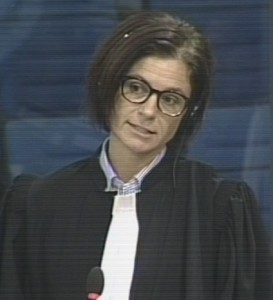
International Civil Party Lead Co-Lawyer Marie Guiraud
International Co-Prosecutor Nicholas Koumjian asked how long this Civil Party application had been in the possession of the defense. Judge Jean-Marc Lavergne said that he believed the witness had answered this particular question and asked whether this was not the case. Mr. Koppe replied that Prak Doeun had talked about government officials being accused, but all the questions about criminal proceedings and accusations were prohibited.
International Lead Co-Lawyer Marie Guiraud took the floor and said that she did not see the legal basis for the defense’s request. The bench could request them to
provide the information, but the defense could not. The defense team could make a new request under Rule 87(4).
As for the document itself, it had been accessible to all parties for a long time. Moreover, the document said that the wife survived, while Prak Doeun’s wife died. Mr. Koppe replied that the other Civil Party had said that the wife was killed. As for the matter of requesting the information from the Civil Party lawyers, he said that “Of course there is no way of forcing the Civil Party lawyers to give the information”. However, if this turned out to be true, this might be a situation of conflicting interests and the Defense Team might therefore take the matter to Australian bar. He was quick to add: “However, we do not wish to go that far.”
Ms. Guiraud said that the French translation was different, in which it said that the wife (“she”) survived and lived in Boribo district today. The English translation was the original. Ms. Guiraud said that the Nuon Chea team should provide a request under rule 87(4) so that the Civil Party Lead Co-Lawyers could respond in writing.
Witness 2-TCW-1000
Next, witness 2-TCW-1000 was ushered into the courtroom. The President Nil Nonn instructed the parties to be careful when using the interviews of the witness, since there were ongoing investigations in Case 003. E319/23.3.48 was shown to the witness to confirm his name and background. The witness confirmed the information.
The floor was then granted to the International Co-Prosecutor. Mr. Koumjian asked whether at some point in life, the witness had joined the military force. The witness replied that he joined it from 1972 until 1975. He joined the army in Kampot province. In 1975, he joined division 164.
Positions in the military
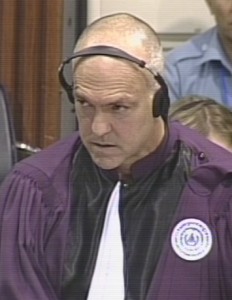
International Co-Prosecutor Nicholas Koumjian
Mr. Koumjian wanted to know who the commander was of the division. The witness replied that there was no division in 1975 yet. Starting from 1976, the division was established with Ta Meas Muth being the commander of the division. According to memory, there one other person called Ta Saroeun and another one called Ta Nhan. Ta Dim form the East Zone disappeared later. Mr. Koumjian asked whether the division had another name before 1976, which the witness denied. Asked by Mr. Koumjian whether he knew about Division 3, he replied that Regiment 3 was divided into Division 164. The division was within the military zone of Kampong Som. Mr. Koumjian asked whether he had ever heard of the army of the Center, which he confirmed. Division 164 was part of the army of the Center.
Mr. Koumjian inquired whether the witness could explain the positions he had held between 1975 and 1979. He replied that he was in Division 164 in Battalion 129 of the Regiment.[2] Mr. Koumjian asked whether he had any specialized training, which the witness denied. Before 1975, he fought on land. However, he fought on water after 1975. He did receive some training before going to the navy. He denied having received political training. He denied that the commander talked about policy.
Mr. Koumjian further inquired what his tasks were when being part of the naval force. He replied that when being in the battalion, he received the orders from the regiment. When being on the boat, he patrolled along the border at night time.
Mr. Koumjian asked whether he encountered other boats, such as boats with refugees or fishermen. He replied that there was no order when being on the sea in battalion 140. When being stationed on the island, however, there was an order to arrest if there was a boat from Thailand. The original island he was based on was Tang Island, and afterwards to Poulo Wai island. He was based on Tang Island in 1975 and afterwards on Koh Poulo Wai. He stayed there until 1977. In 1977, he was assigned by Angkar to the naval force. He was based at Ou Chheu port. Boats would go out to fight if there was an order. He received no orders until the Vietnamese arrived.
This prompted Mr. Koumjian to ask whether he never received orders and could decide freely what to do. He replied that he would only do something when he received “orders to go out.” The witness replied that he did not receive the order to patrol. “I was in the chasing naval force.” There would be orders when “there was an incident” in order “to do the work”.
Mr. Koumjian asked whether he was aware of orders to stop motorboats, and to sink them if they refused to do so. The witness replied that he did not receive orders to sink the boats at the time.
Mr. Koumjian proceeded to read out an excerpt “if we ordered any motorboat to stop and they did not follow our orders”, they could be sunk right away.[3] These orders came from the divisions. The witness replied by explaining the chain of command from division to battalion.
Mr. Koumjian inquired whether there was an order to report to the upper echelon who were on this boats and what ethnicity they had. He replied that there were reports from one level to the next. The reports went from one report to the upper level. As for Vietnamese, they had to send them to land if there was an order to do so. He did not know where the Vietnamese were sent to.
Mr. Koumjian referred to the next answer, in which the witness had said that there were “clear orders” on whether people on boats they intercepted were to be killed “on the spot” or arrested. Further, he had told the investigators that confessions had to be broadcasted about the radio before killing the people.[4] Mr. Koumjian wanted to know whether this was correct, which he confirmed. He did not know who they were ordered to kill them right away. “I myself never executed anyone.” He did not know where they recorded the confessions.
Mr. Koumjian referred to Duch’s – the commander of S-21 – testimony in Case 002/01 of April 03 2012 and inquired whether he ever heard the confessions broadcasted of someone who he had arrested. The witness replied that he did not know.
Mr. Koumjian inquired whether the witness himself ever captured people in boats. He replied that he himself did not make the arrest. Mr. Koumjian inquired whether he was not involved in the capture of Vietnamese refugees, which he denied. Mr. Koumjian asked whether it happened that he was on a boat that captured Vietnamese refugees, amongst them a man whose hand was amputated. The witness replied that he was part of the navy unit already. “I saw the incident with my own eyes” at the port.
At this point, the President adjourned the hearing for a break.
Executions
After the first break, Mr. Koumjian took up his questioning. He asked whether it was possible to disobey orders, which the witness denied. “If there was an order coming down, we needed to enforce it.” Asked what happened to those who disobeyed an order, he replied that these people “would face problems.” He explained that they might be arrested or sent to re-education.
Mr. Koumjian read out an excerpt of the witness’s statement, in which he had said of having been part of transporting 12 or 13 captured people, amongst them a man with an amputated hand.[5] The witness confirmed this story and remembered that they were taken to Ou Chheu Teal Port. They were ethnic Vietnamese people. The man with the amputated hand was a soldier, the rest were ordinary people. They had answered that they were heading for Thailand. There were no guns. There was a baby on board. The baby “cried loudly”, because the mother was tied up. “Then the soldiers threw the baby into the sea.”
In 1977, he witnessed a harmful incident once or twice. Later, there was no incident where harm was caused to the arrested people. The other ones were arrested and sent away. He did not know where they were sent to.
In one of his interview, he had said that the numbers of people was in the thousands during the year that he worked at Ou Chheal Teal Port with each month between 10 and 50 persons being captured, including Vietnamese refugees and Thai fishermen.[6] Mr. Koumjian inquired whether this information was correct, which he confirmed. “I would like to apologize that I could not recall everything from 1977 to 1978”. He remembered that ethnic Vietnamese and Thai fishermen were arrested and killed. He did not go beyond his place. At Ou Chheu Teal Port, people were transported to Kampong Som. They were killed, but he did not know the exact location of their execution. They were also killed on orange and coconut plantations.
Mr. Koumjian inquired how the witness learned that people were killed at coconut plantations. The witness replied that he used to live near the orange plantation in 1977, because he “was punished”, so he had to do rice farming near Ream. People who were killed came from the regiment where he worked, namely Regiment 162. The people who were arrested by the regiment were killed and their dead bodies used as fertilizers. The people who were killed were Thai and ethnic Vietnamese people.
Mr. Koumjian asked how he learned about those killings. He replied that he lived close to that place. Some of the soldiers lived with him. “I asked them and those soldiers told me that there were executions.”
Mr. Koumjian wanted to know why the witness was being punished at the time. He replied that they had disciplined him and did not have confidence in him as a good soldier. There were 12 people in his group. At that time, “there were bad words” and “they considered us divorced”, so they arrested one person of the battalion. They saw one bad word somewhere, so they were “at the time I was illiterate”, so he told them that he could not write. Around five or six people were arrested. This event had as a consequence that “they withdrew confidence from me.” They punished him by sending him to Ream. Mr. Koumjian asked whether they had written down “Tamil” or “devil”, which the witness corrected as meaning “communist devil”.
Mr. Koumjian inquired whether he also learned about the fate of 17 April People in that area. He replied that he knew about the 17 April People in Koki village. At the end of 1977, he knew about this, since he was assigned to work with the 17 April People. When he farmed rice with them, he noticed that they disappeared “one after another.” He asked a soldier about this, who told him that those 17 April People were transported on trucks and killed at Chamnaot Ream execution site.
Capture of Vietnamese and Thai people
Mr. Koumjian inquired whether there was a difference between the treatment of the Thai and the Vietnamese when they were captured. He replied that there were different treatments. In 1976, “I myself arrested the ethnic Vietnamese from a boat consisting of about 10 people and among them they were armed and they shot at us. So there came an order from the upper level to sink them, because they shot at us. So we sank their boat. Later on, I arrested three Thai ships, […] Each boat consisted of 15 people, 20 people. Those Thai fishermen were sent to Ream.” He said that he met those Thai people when he was assigned to work at Ream, before correcting himself that it was actually on Koh Ta Kiev. He had asked a guard what would happen to these people, who told him that they would not kill these Thai people but send them back to Thailand.
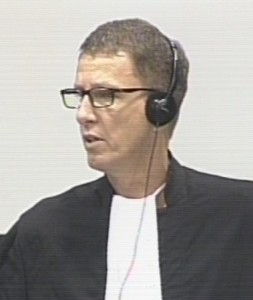
International Nuon Chea Defense Counsel Victor Koppe
When Mr. Koumjian asked what would happen to the Vietnamese people who were not armed were arrested, Mr. Koppe interjected and stated that the Prosecution made it seem like one could only be a refugee or a soldier. “It is standing practice also today that the boat it stopped” if an unknown boat entered the territory of a state. He submitted that a person does not wear a uniform or an arm did not mean that this person could not be a soldier. Mr. Koumjian said that counsel would have three quarters of a day next year “to ask all those questions.”
Mr. Koumjian then repeated his question. The witness replied that the Vietnamese people were regarded differently from Thai, since they were considered being the hereditary enemy and needed to be shot when they carried a gun. Mr. Koumjian asked about the people who did not have guns, since he had said that many of them were refugees. He replied that those who did not have guns were arrested and sent to the division headquarters in 1977. This was when he was still with 162 and not 164 yet. When he captured or sank boats, this was on order from the battalion or a
When there was a Vietnamese boat with guns, the Cambodian boat would chase them. When there was a Vietnamese boat and the people on it had guns, regardless of whether they were civilians or military, the ship had to be sunk.
Mr. Koumjian then referred to the witness’s DC-Cam interview from 2007.[7] He had said that “if they had arrested Yuons, they would kill them.” The witness had further said that these people were sometimes killed on the island and were mostly refugees escaping from a war and travelling through their area. According to this interview, the order to kill from Ta Muth, Mr. Koumjian inquired whether the witness could explain where those orders came from to kill refugees. The witness replied that it was true what Mr. Koumjian had read. Most of the Vietnamese boats “went to the third country.” There were orders from the division. The division did not order directly to his unit. The order came “hierarchically from top to the bottom.” As for the Vietnamese, “some of them were sent to us” and on other occasions, if there were many Vietnamese, they would be sent ashore. If there were only a few, they would be killed on the island. This happened when he was in Regiment 622. Later on, he was at Ou Chheu Teal, whereas the situation happened at Poulo Wai Island.
Mr. Koumjian asked whether he remembered a particular incident about a Vietnamese incident and a one year old infant. He recounted that a husband, his wife and their child were arrested. After they were sent to Poulo Wai Island, he saw soldier from the special regiment 622. They tied the three Vietnamese and “put them under a coconut tree. Later on, they were killed with the hoes and the bamboo clubs and the three Vietnamese died. They were killed to kneel down under the coconut tree. […] The one year ol child, when it saw the mother was bleeding, the baby growled to the mother. At the time, the soldier picked up the baby and smashed it against the coconut tree.” These people were civilians; they had no military uniform. They were captured five kilometers away from Poulo Wai Island. The boat was small.
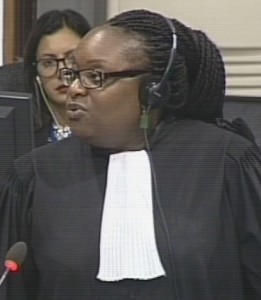
International Khieu Samphan Defense Counsel Anta Guissé
Mr. Koumjian asked how the orders were communicated and whether the boats had radios. The witness replied that there was a radio operating system on each system. When there was a capture, “we had to make a report to the battalion”, which would make its report to the division. As for written reports, the witness replied that they were compiled.
Mr. Koumjian requested leave to show the witness a report, which was granted.[8] At this point, Mr. Koppe objected, albeit saying: “I know you will deny my objection.” He argued that the witness was low in the hierarchy, and had no knowledge about reports from upper levels. “He has nothing intelligent to say about a division report allegedly going up.” Khieu Samphan Defense Counsel Anta Guissé supported Mr. Koppe’s objected and argued that questions needed to be asked to establish the link between
Judge Jean-Marc Lavergne asked whether this report concerned arrests, which Mr. Koumjian confirmed. It referred to the arrests and, in Mr. Koumjian’s view, the
executions of Vietnamese people who were captured. Ms. Guissé stated that questions should be asked about the specific incident to establish the link to the witness. The floor was then granted to Civil Party Lead Co-Lawyer Marie Guiraud said that the document had already been presented to the witness during his interview.[9] After briefly conferring with the bench, the President announced that the objection was overruled and the document represented to the witness.
Mr. Koumjian said that the document indicated the date of having been drafted on 1 April 1978 and originating from Division 164. Mr. Koumjian asked whether he was part of Division 164 at the time. The witness replied that he was part of the division from 1978 and 1979 and confirmed that he was part of the division at the time.
Mr. Koumjian said that it seems to have been signed by Muth and asked who in the division 164 Muth was. The witness replied that this referred to Meas Muth, who was the commander of the division in Kampong Som.
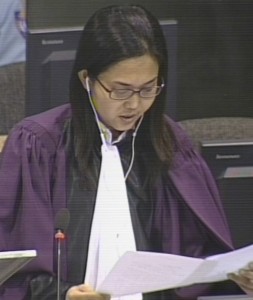
Deputy Co-Prosecutor Song Chorvoin reads the disputed document.
The document indicated that the total number of arrested people and shot to death between in a specific period in March 1978 was 120. When Mr. Koumjian inquired whether the witness had any knowledge about the incident, Mr. Koppe objected to the phrasing of the question: he had used both documents, extracting different parts of the translation of both. For example, one document said “total number of arrested and fired Vietnamese”, while the other document used the words “shot to death”. Mr. Koumjian stated that Mr. Koppe’s national colleagues could object to the translation if they thought it was inappropriate. Mr. Koppe suggested that Mr. Koumjian’s national colleague could read out the document while the translators simultaneously translated it. The advice was followed and Ms. Song Chorvoin read the document. The translation said “shot to death.”
Mr. Koumjian asked whether the witness remembered any such incident. The witness replied that he could not remember the story described in the document.
Mr. Koumjian moved to another time period: after the fall of the regime, the witness had worked as a messenger. He wanted to know whether this was correct, which the witness confirmed. “I was a messenger and a guard of Ta Muth.” There were around 30,000 people that he took from Kampong Som to Thailand. Meas Muth had ordered him to bring those people to Thailand.
Mr. Koumjian asked whether this type of message in Division 164 was common between Meas Muth and the other people. At this point, Mr. Koppe objected: “This is a clear invitation for the witness to speculate.” The objection was overruled.
The President adjourned the hearing for lunch break. He informed the parties that there would be a swearing-in ceremony at 1 pm.
The Vietnamese as the hereditary enemy
After the lunch break, the floor was then granted again to the Co-Prosecution. Mr. Koumjian wanted to know where the witness had heard that the Vietnamese were the hereditary enemy. He replied that he was a soldier in Division 164. After 1976, there was a training in which they clearly announced that the Vietnamese were the hereditary enemy. The training was given at the battalion. There were trainings at each battalion in the division. The commanders of each battalion gave the training. No one “dared to debate about what we were taught about the hereditary enemy.” He recounted: “we were instructed to kill, even if it was a baby, because they are our hereditary enemy, so we must kill them, so it was the responsibility of each battalion to enforce these instructions.” These instructions had to be enforced. With this, Mr. Koumjian finished his line of questioning.
The floor was granted to the Lead Co-Lawyers for the Civil Parties. Ms. Guiraud started by saying that he had stated attended two technical trainings before joining division 164 on the island, and asked whether she understood him correctly. He replied that he was trained at the military school. “Yes, I attended the training.” The training was at Koh Rong and Koh Mnnoas later, before he went back to Sokha hotel. He was trained for three months. His instructor was called Cham. He was the trainer of the military tactics. He studied in China. After having completed his studies in Chine, Cham came to train them. As for Chinese influence, there were only the Chinese instructors “coming by vehicle with their interpreters.”
Ms. Guiraud then wanted to know whether his instructor attended training himself, which he did not know. He taught him at a training school.
This prompted Ms. Guiraud to refer to one of his interviews.[10] Here, he had said that the instructors had undergone training at the level of the division before giving training to the soldiers.
The command headquarter was located at a roundabout in Kampong Som.
During his time at Battalion 622, he did not know about the affairs of the upper level.
Ms. Guiraud turned to the interception of vessels on the sea. He confirmed that they arrested those who were armed – even if they were not soldiers – when they were in the territorial waters of Cambodia. Ms. Guiraud asked to describe the procedure on how to identify the origins of the people and how to determine whether they were soldiers or not. He replied that mostly other people did the patrolling.
Turning to her last series of question, Ms. Guiraud asked him to confirm whether it was the order to send people to Ou Chheu Teal when they were more than twenty.[11] The witness said that this was the case. He recounted that if the number of the arrested people was only small, the people would be killed on the island and only the vessel would be brought to the land. She asked whether he knew why there was a distinction made between vessels that carried more than 20 people and vessels that carried more. He replied that there was an order to kill them on the spot, since “they did not want to bother with interrogating them”. Only if there was a larger number, they would be interrogated.
The floor was then granted to Judge Lavergne, who asked whether he properly understood that the witness had joined the army in 1973. He said that this was not correct, but that he joined the army in May 1972. Judge Lavergne asked whether it was at the time of the FUNK (National United Revolutionary Front) and whether he was a party member at the time, which the witness denied: I was an ordinary soldier. Judge Lavergne asked where the witness was in 1975 and in which fighting he participated. The witness replied that he left the military in 1975 from Kampot Province and joined the division in that year. He was in Kampot on 17 April 1975. Judge Lavergne asked whether he left immediately after the liberation in April 1975. He replied that he went to Kampong Som afterwards. He was assigned by his unit. The situation “was still chaotic” then.
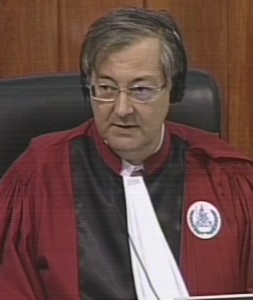
Judge Jean-Marc Lavergne
Judge Lavergne asked whether he received official instructions from the Lon Nol officials. The witness replied that the instructions from the battalion and the regiment were that soldiers and 17 April People had to be evacuated from the city.
Judge Lavergne asked whether he witnessed any arrests after the arrests. He replied that the military was not allowed to have any contact with the people. Judge Lavergne asked whether it was therefore correct that he was ordered to evacuate the people from the city and that other people from a higher level were responsible once the evacuation had been done.
Judge Lavergne the turned to the punishment he had received when being suspected. He wanted to know whether they were sent to Teuk Sap, which he confirmed. He was sent there, too. Only soldiers from the regiment were detained there, no 17 April People or former officials. The soldiers who he had known from 164 were sent there, since “they had some, you know, activities against the regime.” Judge Lavergne then wanted to know whether he had to write his biography and if yes, what he had to include. The witness replied that 1975 was the liberation day. After “the screening of the soldiers” by drawing biographies, he had relatives and a father who had been a former soldier. Those who were linked to the former officials were removed from the division or the military unit. “It is true that all soldier servicemen had to make biographies.” He had to write his biography two to five times per year, he estimated. After having made the biography, they had to declare whether they had any “bad elements” in their family background. If there was any bad element, this biography would be kept “forever.”
In 164, there was a mobile unit headed by Ta Chhay. Those who were linked to so-called bad elements would be put in one group. For instance, if he had a parent who was linked to the CIA or KTB, he would be moved to another unit.
Judge Lavergne asked whether the witness himself had been sent to re-education or to a mobile unit. He replied that he was not relocated to a mobile unit. “Why was I not relocated to a mobile unit? It was because I was trying my best to re-fashion myself.” Thus, he was trusted by his battalion and regiment. “So it depended on the offenses committed by the servicemen.” If they had committed serious offenses, they would be sent to Teuk Sap. Those who had links to former Lon Nol officials would be sent to a mobile unit.
Those who had relatives who were linked to “former tendencies” would be sent to the mobile unit headed by Ta Chhay. There were 400 or 500 people within that mobile unit. There were around 50 or 60 people at Teuk Sap. He could see those who were located at the mobile unit “very often”, while he saw those who were detained at Teuk Sap “once in a while.”
After having tried to re-fashion himself, he was “considered a good person” and he was taken back into his regiment. He was relocated and stationed at his original island.
He worked together with someone also at Koh Ta Kiev. Those people who he lived with “were doing their best.”
Judge Lavergne returned to the fate of the 17 April People and asked whether he knew why the 17 April people disappeared. He replied that they disappeared from time to time. He heard that two truckloads of people were sent away and killed. After this, he did his best to re-fashion himself. Judge Lavergne asked whether they had been looking for those who had been officials under the Lon Nol regime. The witness replied that as for the biographies, “no one had links” to former Lon Nol servicemen within all units. If someone had links, “they would be in a difficult or a dangerous situation.” Those who had ties were removed out of the military unit. To his knowledge, the biographies were not collected from the 17 April People.
Judge Lavergne asked whether he remembered Ta Dim, which the witness confirmed. He corrected the pronunciation and recounted that he was part of the East Zone. One regiment of his troops were sent to Kampong Som. However, he was under Ta Muth’s leadership. Ta Dim had been the person under Ta Muth and was arrested. After his arrest, other arrests were made amongst his soldiers. His troop disappeared later. He did not know where the soldiers of Ta Dim were sent to. He said that Ta Dim’s confession might have implicated the soldiers. He noticed that one time, three or four soldiers were arrested. After Ta Dim’s arrest, his unit was “dismantled.” The soldiers were dispersed. The arrests took place many times with three to ten soldiers being arrested.
His understanding was that soldiers under Ta Dim were linked to Ta Dim’s activities. He recounted that he did not hear any confessions related to the Vietnamese when he was with the navy. He heard broadcasts over the radio, but did not pay close attention. “I did have no free time to enjoy listening to the radio.” Offenses would be announced on the radio and the confessions would be broadcasted, but the soldiers were not able to listen to the broadcast. “As a soldier, we had to – in the morning .have the training session, and after that carrying dirt, and we had one hour for lunch. And after lunch, we had to go back to work, so we had no free time at all.”
Judge Lavergne asked whether he had heard of the Revolutionary Flag or Revolutionary Youth Flag, which he confirmed. However, he did not focus on this. “My main task was to re-fashion myself.”
Judge Lavergne asked whether they had Chinese advisors in the army except the instructors, which the witness denied. He did not see any Chinese advisors at the training sessions – after the inauguration of the training session, the Chinese people left.
As for equipment that they had in 164, the witness recounted that there were big and small ships; technical equipment stemmed originally from China, including radar systems and radio systems. This was the last question of Judge Lavergne.
Clarifications
Mr. Koumjian stated that he had noticed that the Trial Chamber requested their submissions that they had filed with regards to the 6th Evidence Request, in particular with regard to summoning Robert Lemkin. The Co-Prosecution had objected to summoning this witness for the Supreme Court hearings, but not to summoning him at the trial in general. By way of illustration, the Co-Prosecution had long requested to summon Tet Sambath, who was the main source for Robert Lemkin’s knowledge. Mr. Koumjian stressed that the Prosecution therefore did not object to summoning this person. The floor was then granted to Judge Lavergne again, who said that it appeared that Vincent de Wilde indicated that there would perhaps be requests for other witnesses to be called regarding the Vietnamese and asked whether such a request would be filed. Mr. Koumjian said that he would like to answer via e-mail later today, copying all parties.
The President clarified that since this witness had been requested by the Co-Prosecutors to appear before the court and the Defense Counsel had requested time to review the relevant documents, the hearing could not continue today. It will resume Tuesday, January 5 2015. Witness 2-TCW-948 will be on the reserve.
[1] E3/4732, at 00427379 (EN). [2] It is not clear whether the number of the regiment was missed in the translation. [3] E319/23.3.44, answer 26 [4] E319/23.3.44, answer 29. [5] E319/23.3.44, in answer 36. [6] E319/23.3.46, at answers 9 and 10. [7] E305/13.23/382, at 00955507-08 (KH), 00980444 (FR), 00978576 (EN). [8] E3/928 and E3/929 (this is the same document with slightly different translation.) [9] E319/23.3.43.3 [10] E319/23.3.44, answer 33. [11] E319/23.3.44, Answer 25.
Featured Image: Visitors at the ECCC on 15 December 2015 (ECCC: Flickr)
